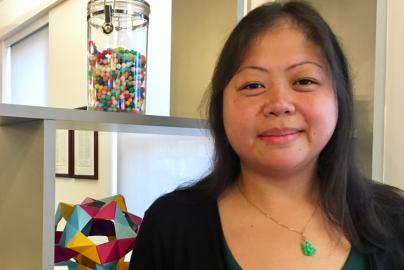
By MƒA Master Teacher Shari Eng
What are the ingredients to a successful learning environment? If you ask this question to any teacher, would answers vary? Definitely.
If you ask this question of a general education and special education co-teaching pair, answers would still vary.
If you ask this question to the same teaching duo five years later, would their answers be the same as before? Probably not.
No doubt their answers would evolve. Co-teaching is unique, and teachers are individuals, each bring their own knowledge and skill to the classroom. This is a benefit to both students, and the teachers themselves. Students should not be the only learners in the classroom. Teachers should be learning, too. Along with learning comes growth. Good teachers continuously modify their lesson plans and their approach to teaching a specific topic and reflect on their students’ growth and end of year results. Good teachers – both general education teachers and special education teachers – don't just teach. Co-teaching pairs do additional work to align their style and skills. Here I’ll share some key commitments my co-teacher and I have discovered so that we can learn and strive, growing continually in our practice while finding balance in our classroom.
I have been teaching for 12 years and the bulk of my teaching has been in a collaborative setting where I am the special education teacher. Flashback to early December of my first year of teaching, I was leaving my period 4 collaborative team-teaching class and heading straight to the bathroom to cry. This had become a routine. As a result, I realized that the special education license had not substantially improved my instruction and confidence as a teacher. It was apparent that I needed to rethink how to improve my instruction as well as maximize my students' learning. My co-teacher and I had to work more intimately and be on the same wavelength regarding our students and what was happening in our classroom. If we weren't going to make a change or improve, how could we expect success for my students? Since then I’ve developed some key strategies to leverage my knowledge as a special education teacher in a collaborative setting. I no longer cry in the bathroom after 4th period!
Through the experiences and reflections of me and my co-teacher, Mrs. Haritos, we have narrowed down four ingredients that make our classroom a successful learning environment for all students.
- Write it down. At the end of each teaching day my co-teacher and I separately jot down notes about anything related to instruction, interaction with students, and edits that need to be made to our lesson plans. At the end of each week, we take these daily notes and write a paragraph reflecting on them. We share those notes with each other, building and tuning our learning from the week. Ultimately, we want to learn how to improve our teaching, student understanding, and how to make the classroom a more successful learning environment. These notes make our conversations more objective and focused. By doing them each day and then revisiting them at the end of the week we keep track of the details while fitting them into the bigger picture.
- Make it about the learning, not the stuff. I am confident every teacher has heard a student ask, "Can I borrow a pencil?” “May I borrow a graphing calculator?" Flashback to my third year of teaching: I would have asked the student why they came to class unprepared and scolded them for their lack of effort. Today, if students ask me the same two questions, I would gladly say “Yes, of course!” In my co-teaching classes we agree on this philosophy at the start of the year so that we can be consistent and supportive to students. We believe if the student is asking to borrow a pencil or calculator then they are ready to learn at that moment and are advocating for their own learning. When a student sits at their desk without any resources and does not ask for help it is actually more troubling! In the past I have worked with teachers that wanted students to have graphing calculators, and if they did not, students would be penalized for not participating in class. This was really difficult for me. Of course, all teachers would love all their students to have all the resources for practice inside and outside the classroom, but realistically, this is not the case. When my co-teacher and I agree on this early, we can focus more on student learning and growth, not on minor things.
- Make groups the norm. A classroom is more inviting when the desks are arranged in quads. We believe that when students are seated in quads, we are creating a collaborative environment where sharing becomes natural and student interaction and working together becomes the norm. We take time to teach students how to work in a group. This time is worth it and soon students can ask each other for assistance, check answers, and self-regulate. When students are seated in quads, we can more easily check-in with each group as well as differentiate student learning. Many teachers move their students from rows into groups of four when an activity calls for group work. Instead, why not seat students in groups and if an activity calls for individual practice, move them into rows?
- Focus on student growth, not student grades. Teachers in a collaborative setting have students with disabilities who are unable to pass in-class assessments or reach mastery level. Since our students struggle a lot in math class, we consider the students' effort and growth as a way of measuring their understanding. We have found that when students know that we are looking for effort and growth rather than a passing grade, they are motivated to learn and explore the content. If teachers understand that not all students achieve at the same level or learn at the same pace and allow growth and effort to be part of their teaching practice, students will enjoy learning more. Likewise, cultivating an environment focused on learning, and not simply grading, is more challenging and enjoyable for the teachers too.
Both special education and general education teachers, especially those in a collaborative setting, have goals for all students. Goals vary from wanting to provide students with the best problem-solving skills or the ability to become lifelong learners or simply helping them pass state exams. Regardless of the type of goals you may have for your students or yourself as a teacher, it is essential to take time with your co-teacher to identify shared ingredients you believe are key to creating a successful learning environment. That way both you and your students will grow and learn together.
